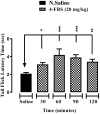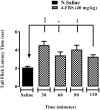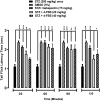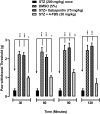Analgesic and Antiallodynic Effects of 4-Fluoro-N-(4-Sulfamoylbenzyl) Benzene Sulfonamide in a Murine Model of Pain
- PMID: 33149549
- PMCID: PMC7602919
- DOI: 10.2147/DDDT.S269777
Analgesic and Antiallodynic Effects of 4-Fluoro-N-(4-Sulfamoylbenzyl) Benzene Sulfonamide in a Murine Model of Pain
Abstract
Introduction: Physical, chemical, thermal injuries along with infectious diseases lead to acute pain with associated inflammation, being the primary cause of hospital visits. Moreover, neuropathic pain associated with diabetes is a serious chronic disease leading to high morbidity and poor quality of life.
Objective: Earlier multiple sulphonamides have been reported to have an antinociceptive and antiallodynic profile. 4-Fluoro-N-(4-sulfamoylbenzyl) Benzene Sulfonamide (4-FBS), a synthetic sulfonamide with reported carbonic anhydrase inhibitory activity, was investigated for its potential effects in mice model of acute and diabetic neuropathic pain.
Methods and results: 4-FBS was given orally (p.o.) one hour before the test and then mice were screened for antinociceptive activity by using the tail immersion test, which showed significant antinociceptive effect at both 20 and 40 mg/kg doses. To explore the possible mechanisms, thermal analgesia of 4-FBS was reversed by the 5HT3 antagonist ondansetron 1mg/kg intraperitoneally (i.p.) and by the µ receptor antagonist naloxone (1 mg/kg i.p.), implying possible involvement of serotonergic and opioidergic pathways in the analgesic effect of 4-FBS. Diabetes was induced in mice by a single dose of streptozotocin (STZ) 200 mg/kg i.p. After two weeks, animals first became hyperalgesic and progressively allodynic in the fourth week, which was evaluated through behavioral parameters like thermal and mechanical tests. 4-FBS at 20 and 40 mg/kg p.o. significantly reversed diabetes-induced hyperalgesia and allodynia at 30, 60, 90, and 120 minutes.
Conclusion: These findings are significant and promising while further studies are warranted to explore the exact molecular mechanism and the potential of 4-FBS in diabetic neuropathic pain.
Keywords: antinociception; diabetes mellitus; DM; neuropathic pain; streptozotocin; STZ; sulfonamides; von Frey filaments.
© 2020 Ur Rehman et al.
Conflict of interest statement
The authors report no conflicts of interest in this work.
Figures







Similar articles
-
Catecholaminergic and opioidergic system mediated effects of reboxetine on diabetic neuropathic pain.Psychopharmacology (Berl). 2020 Apr;237(4):1131-1145. doi: 10.1007/s00213-019-05443-5. Epub 2020 Jan 7. Psychopharmacology (Berl). 2020. PMID: 31912189
-
Effect of curcumin on diabetic peripheral neuropathic pain: possible involvement of opioid system.Eur J Pharmacol. 2014 Jan 15;723:202-6. doi: 10.1016/j.ejphar.2013.11.033. Epub 2013 Dec 4. Eur J Pharmacol. 2014. PMID: 24315931
-
The application of support vector regression for prediction of the antiallodynic effect of drug combinations in the mouse model of streptozocin-induced diabetic neuropathy.Comput Methods Programs Biomed. 2013 Aug;111(2):330-7. doi: 10.1016/j.cmpb.2013.04.018. Epub 2013 May 18. Comput Methods Programs Biomed. 2013. PMID: 23693136
-
Passiflora incarnata attenuation of neuropathic allodynia and vulvodynia apropos GABA-ergic and opioidergic antinociceptive and behavioural mechanisms.BMC Complement Altern Med. 2016 Feb 24;16:77. doi: 10.1186/s12906-016-1048-6. BMC Complement Altern Med. 2016. PMID: 26912265 Free PMC article.
-
The antihyperalgesic effect of docosahexaenoic acid in streptozotocin-induced neuropathic pain in the rat involves the opioidergic system.Eur J Pharmacol. 2019 Feb 15;845:32-39. doi: 10.1016/j.ejphar.2018.12.029. Epub 2018 Dec 21. Eur J Pharmacol. 2019. PMID: 30582909
Cited by
-
Effects of 1-methyl-1, 2, 3, 4-tetrahydroisoquinoline on a diabetic neuropathic pain model.Front Pharmacol. 2023 Mar 22;14:1128496. doi: 10.3389/fphar.2023.1128496. eCollection 2023. Front Pharmacol. 2023. PMID: 37033637 Free PMC article.
References
MeSH terms
Substances
LinkOut - more resources
Full Text Sources
Medical

